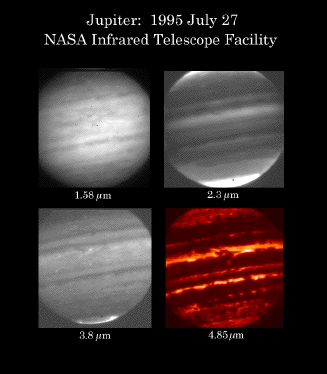

NOTE: Click on the image to view it at its highest resolution.
At a wavelength of 1.58 microns, we sense sunlight reflected from cloud particles with virtually no absorption by Jupiter's gases. Thus, the variations from one region to the next indicate changes of the reflectivity (albedo) of cloud particles. The appearance of the planet at 1.58 microns is the closest near-infrared analogue of its visible (red) appearance.
At a wavelength of 3.8 microns, we sense two sources of radiation. One is sunlight reflected from cloud particles in Jupiter's upper troposphere which has not been extinguished by weak methane (CH4) gas absorption. The Great Red Spot is seen as a high cloud on the right, just below the center; the brightest reflection - and probably the highest cloud particles in this region - are detected in discrete plumes just north of the equator, close to the latitude in which the Galileo Probe will enter on December 7. The other source of radiation comes from emission by H3+ from an airglow which covers the planet and is most pronounced at the edge of the disk (the limb) and from auroral emission near the poles. This image has captured oval-shaped H3+ auroral emission near the south pole.
At a wavelength of 2.3 microns, we sense sunlight reflected from cloud and haze particles higher up - in Jupiter's lower stratosphere - which have not been extinguished by methane (CH4) and molecular hydrogen (H2) gas absorption. The most prominent features are the particulate caps covering the poles (in this image, the dark spot in the middle of the south polar cap is an artifact of the NSFCAM optics at the time). From mid-latitudes toward the south pole, the moderate reflecting particulates are mostly remnants of particles remaining from impacts of Comet Shoemaker-Levy 9 fragments near 45 deg.S lat., now distributed rather uniformly over longitudes and migrating far to the south and somewhat to the north of the impact latitude.
At a wavelength of 4.85 microns, we are sensing heat from Jupiter, which we indicate by the false red shading. The darkest regions correspond to emission from temperatures near 185 Kelvins (-190 deg. F) and the warmest regions to temperatures near 255 Kelvins (-64 deg. F), indicating emission from 1 - 5 bars of atmospheric pressure in Jupiter. The absence of strong gaseous absorption at this wavelength means that we are sensing temperatures near the tops of clouds in the atmosphere. The brightest spots are discrete regions which are locally clear of obscuring clouds, known as ``hot spots''; they are one of the special targets planned for the atmospheric investigations by the Galileo Orbiter instrument teams. Note that there is a relatively bright (clear) but broken band to the north of the Great Red Spot. There are also bright rings around several of the visibly white oval features south of the Great Red Spot.
This image is catalogued as JPL color negative P-46230 AC.